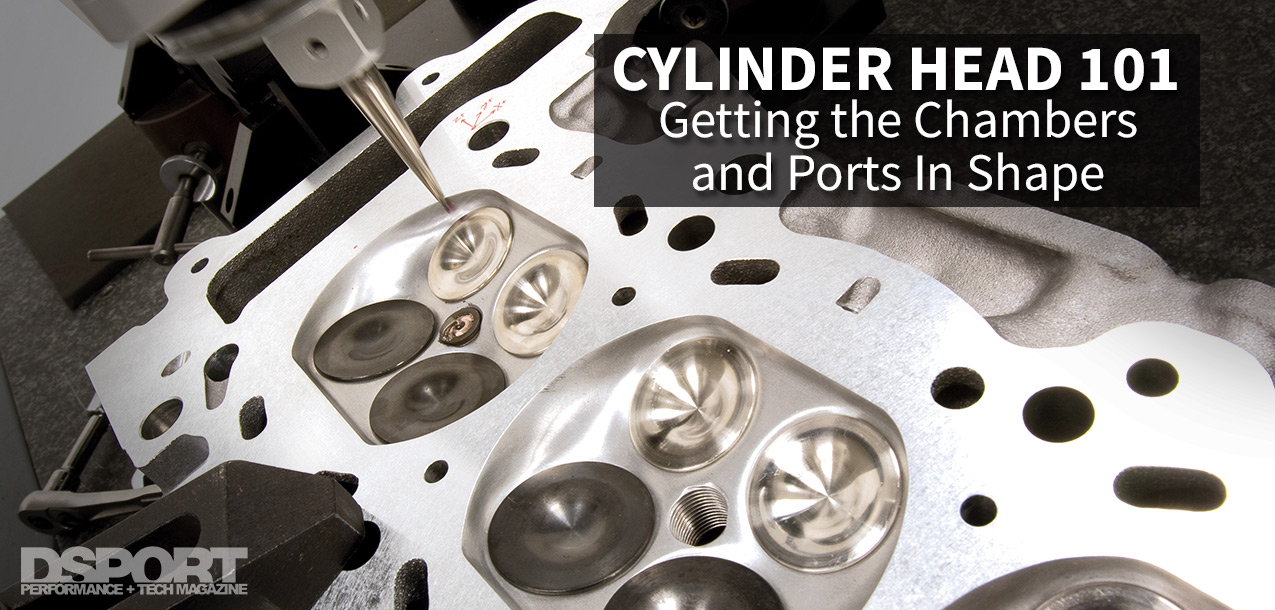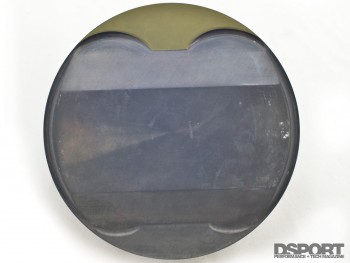Like the cylinder block, the cylinder head is also responsible for holding a number of other components, namely the valvetrain. The valve guides, valve seats, valves, valve springs, valve retainers, valve locks, buckets, followers, lash caps and camshafts are all fitted to the cylinder head. In addition to this responsibility, the cylinder head also plays a role with respect to engine performance. The shape of the combustion chambers, intake ports and exhaust ports will all influence the performance characteristics of the engine.
By Michael Ferrara // Commentary by Allan Lockheed Jr.
DSPORT Issue #105
Chamber
 Even if you are planning to use a set of off-the-shelf pistons, which provide performance advantages over stock pistons, you may want to consider having the combustion chambers of your cylinder head CNC machined. When properly processed, the CNC chambers will reduce the variance in compression ratio across cylinders. In addition, it will also tend to equalize the burn rate and, when done properly, should eliminate any potential hot spots in the combustion chamber. Machining the chamber also allows deshrouding of the valves which can improve port flow substantially. These benefits allow the engine to run more smoothly as each cylinder is likely to produce equivalent power.
Even if you are planning to use a set of off-the-shelf pistons, which provide performance advantages over stock pistons, you may want to consider having the combustion chambers of your cylinder head CNC machined. When properly processed, the CNC chambers will reduce the variance in compression ratio across cylinders. In addition, it will also tend to equalize the burn rate and, when done properly, should eliminate any potential hot spots in the combustion chamber. Machining the chamber also allows deshrouding of the valves which can improve port flow substantially. These benefits allow the engine to run more smoothly as each cylinder is likely to produce equivalent power.
In Japan, a number of top machine shops offer CNC machining of combustion chambers. We sent our Project RH9 GT-R’s cylinder head to NAPREC in Japan to undergo the process. Once the head is received at NAPREC, it’s attached to the fixture that positions the head properly for the machining process. A multi-axis CNC mill then machines each combustion chamber to the same finished shape and volume. The end result is chambers that are within 0.2cc of each other, instead of a factory variance that may be up to 10-times greater. We previously sent out a different cylinder head project to another CNC-porting company. The finish was horrible. That company obviously spent little time in machine setup, programming and tooling to do the job right. The bottom line is that not all CNC chamber processing is equal in quality, so find the right company.
Modern machining puts custom pistons with optimized crown shapes and valve reliefs within easy reach.
To Quench or Not-to-Quench
Most modern four-valve cylinder heads feature a pentroof design with quench pads behind the intake and exhaust valves in the chamber. When the piston is at Top-Dead-Center (TDC), a good percentage of these quench pads are matched by a flat portion on the piston crown. As the piston rises up on the compression stroke approaching TDC, the air and fuel in the quench area is squished out into the center of the combustion chamber. This squish creates turbulence that improves the quality of the fuel-air mixture and combustion. The tighter the squish clearance, the better; as long as piston- to-head contact is avoided. [pullquote]AN OPTIMIZED SHAPE FOR A PISTON AND COMBUSTION CHAMBER ALLOWS COMBUSTION TO PROCEED AT A CONTROLLED AND ACCELERATED RATE.[/pullquote]Some engine builders set this clearance as low as 0.028-inch for a full competition engine, while others never go below 0.040- inch. For the street, the current consensus seems to be a piston-to-head clearance of 0.040-to-0.050-inches. This clearance is critical, because operating at a clearance between 0.055-inch and 0.110-inch actually promotes detonation. Since 1.1mm (or 0.043-inch) head gaskets are among the most popular for import engines, building your engine with a deck between zero and -0.007-inch (piston below the deck) is generally a good target. All of the mentioned clearances are for steel rod engines. Builders of aluminum rod engines should consult the manufacturer for recommendations. When you set an engine up with a tighter quench clearance, be sure to look at the cylinder head quench pads and piston squish areas for evidence of contact during any teardowns.
An improved quench effect combined with the shorter more compact area that the ignition flame front will travel, means complete combustion occurs sooner. This also means that less ignition timing will be required for peak torque. Peak torque should also be higher as the higher cylinder pressures will build after the crank passes TDC at the end of compression and beginning of the power stroke. An optimized shape for a piston and combustion chamber allows combustion to proceed at a controlled and accelerated rate, avoiding detonation and delivering more performance and economy.




